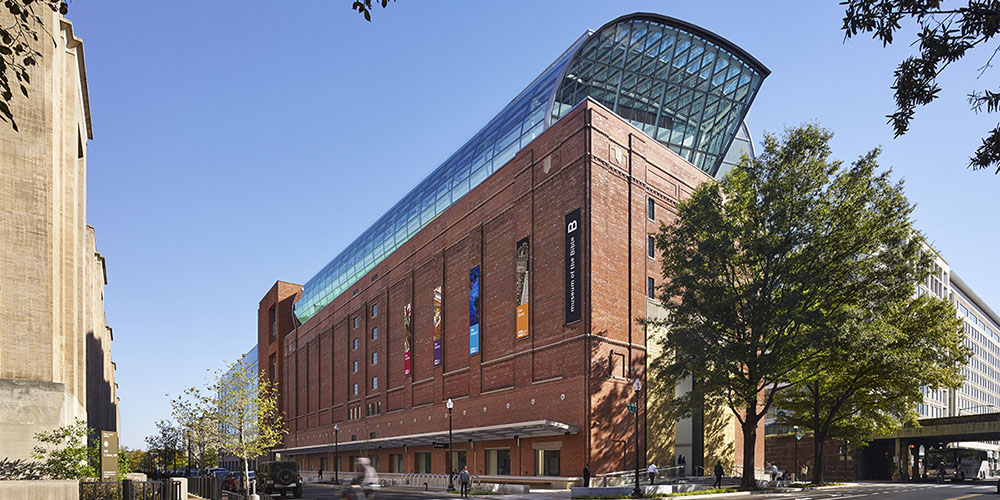Bible Museum Opens Soon in Washington
If you love God’s Word and Israel, you won’t want to miss the Museum of the Bible’s grand opening in November in Washington, DC.
Located only three blocks from the United States Capitol Building and two blocks from the National Mall, the $500-million, 430,000-square-foot enterprise boasts the most technologically advanced, largest Bible museum in the world. Its high-tech, interactive exhibits will explore the Bible’s impact, history, and narrative in a way that’s never been done before, with special emphasis on the Scriptures’ Jewish context.
It takes nine eight-hour days to see everything. But thanks to new technology invented exclusively for the Museum of the Bible, you can visit again and again and pick up where you left off. That’s because you will receive a handheld, digital docent device. The iPhone-like guide will let you customize your tour by entering the topics you are most interested in and the amount of time you are able to spend in the museum that day. Then it will store the information indefinitely, so you can resume your tour when you return.
Once the digital docent has customized your tour, its indoor GPS navigational system will guide you on a personalized journey through the museum. Its inner GPS capabilities also will allow families or groups to locate one another in the museum.
Preserving the Bible’s Jewish Roots
To guarantee the museum’s authentic representation of the Bible’s Jewish history, Museum of the Bible President Cary Summers required all exhibit designers to visit Israel before they began working. “If they are going to be designing a museum about the Bible, then they need to visit and be familiar with the land of the Bible. Nothing enhances your understanding of the Bible like actually seeing the places it describes,” said Summers.
The museum features more than 40,000 ancient, biblical artifacts from the Green Collection, the private collection of Hobby Lobby President Steve Green, the museum’s visionary leader and chairman of the board. Highlights from the Green Collection include the second-largest private collection of Dead Sea Scroll fragments; the world’s largest private collection of Torah scrolls; the world’s oldest known, complete Jewish prayer book; and some of the earliest known New Testament writings.
But the museum’s collection doesn’t stop there. In an effort to further accentuate the Bible’s Jewish roots, the Museum of the Bible joined forces with the Israel Antiquities Authority, Israel’s government-mandated archaeological organization, to display some of its 2 million artifacts in an exclusive, 4,000-square-foot, top-floor exhibit. “The rare opportunity to have a long-term exhibition in the U.S. capital of a large selection of archaeological treasures that were excavated in Israel and illuminate the story of the Bible is remarkable. We hope that the many expected visitors will enjoy the archaeological exhibits and learn about the periods and descriptions of the Bible and the rich and diverse history and the archaeology of the Holy Land,” said Israel Hasson, director of the Israel Antiquities Authority.
Take a Digital Flyboard Ride
This museum is like no other. Its three main exhibit floors include the Impact, History, and Narrative floors. The Impact Floor explores the Bible’s influence on cultures and civilizations, music, film, fashion, science, education, government, America’s founding, pop culture, family, and even individual lives. “The Bible is the bestselling, most-translated book of all time and is arguably history’s most significant piece of literature,” said Green. “It has had an unquestionable influence on science, education, democracy, arts, and society. This book has also profoundly impacted lives across the ages, including my own.”
This floor also features a digital flyboard ride that can take you on a virtual tour through Washington, DC, to learn about the Bible’s impact on America’s founding and to see where Scripture is engraved on national monuments.
The History Floor takes visitors on a journey to see how a series of writings became the most widely read text in history. Using modern cinematic storytelling, multitouch interactive tables, and more than 500 artifacts, the exhibits present the story of the Bible’s preservation, translation, and transmission. Highlights include writings dating to the time of the Hebrew patriarch Abraham, some of the oldest known copies of the Hebrew Bible and New Testament, first-edition Bibles, a 2,100-year-old Genesis fragment from the Dead Sea Scrolls, a Jewish prayer book from the ninth century, and the Torah Room.
The Torah Room houses the largest private collection of Torah scrolls in the world. Spanning more than 700 years, the collection includes scrolls from the Spanish Inquisition and scrolls seized by the Nazis during World War II. The collection will grow as a scribe writes a new scroll and donates it to the museum each year.
After you journey through the Bible’s history, you will step into the biblical narrative through riveting presentations and immersive, walk-through experiences. Comprised of 50,000 square feet, the Narrative Floor includes a 45-minute walk-through of the Jewish Bible, a re-creation of first-century Nazareth, and a New Testament theater.
After walking through the first half of the Bible, you will see and experience “The World of Jesus of Nazareth,” a re-creation of Jesus’ hometown as it existed 2,000 years ago, put together in cooperation with Nazareth Village in Israel. People dressed in first-century garb will display authentic male and female fashion from the time, and you will be able to walk through a first-century Jewish home, synagogue, and carpenter’s shop. Visitors will experience what first-century Jewish worship was like in the synagogue and what it was like to live, cook, and sleep in a first-century home.
The Narrative Floor ends at a 270-degree theater with the story of the New Testament as told by the Gospel writer Luke.
Other museum features include a children’s gallery, a state-of-the-art conference center with views of the Capitol, a ballroom modeled after the French Palace of Versailles, a 500-seat performing arts center, a rooftop biblical garden, and a restaurant that highlights foods of the Bible––including a kosher restaurant.
From the 40-foot bronze entrance doors flanked with the first page of Genesis to the thousands of ancient biblical artifacts and the museum’s interactive and immersive exhibits, the Museum of the Bible promises visitors an unforgettable experience centered on the Book that has changed countless lives throughout the ages.








